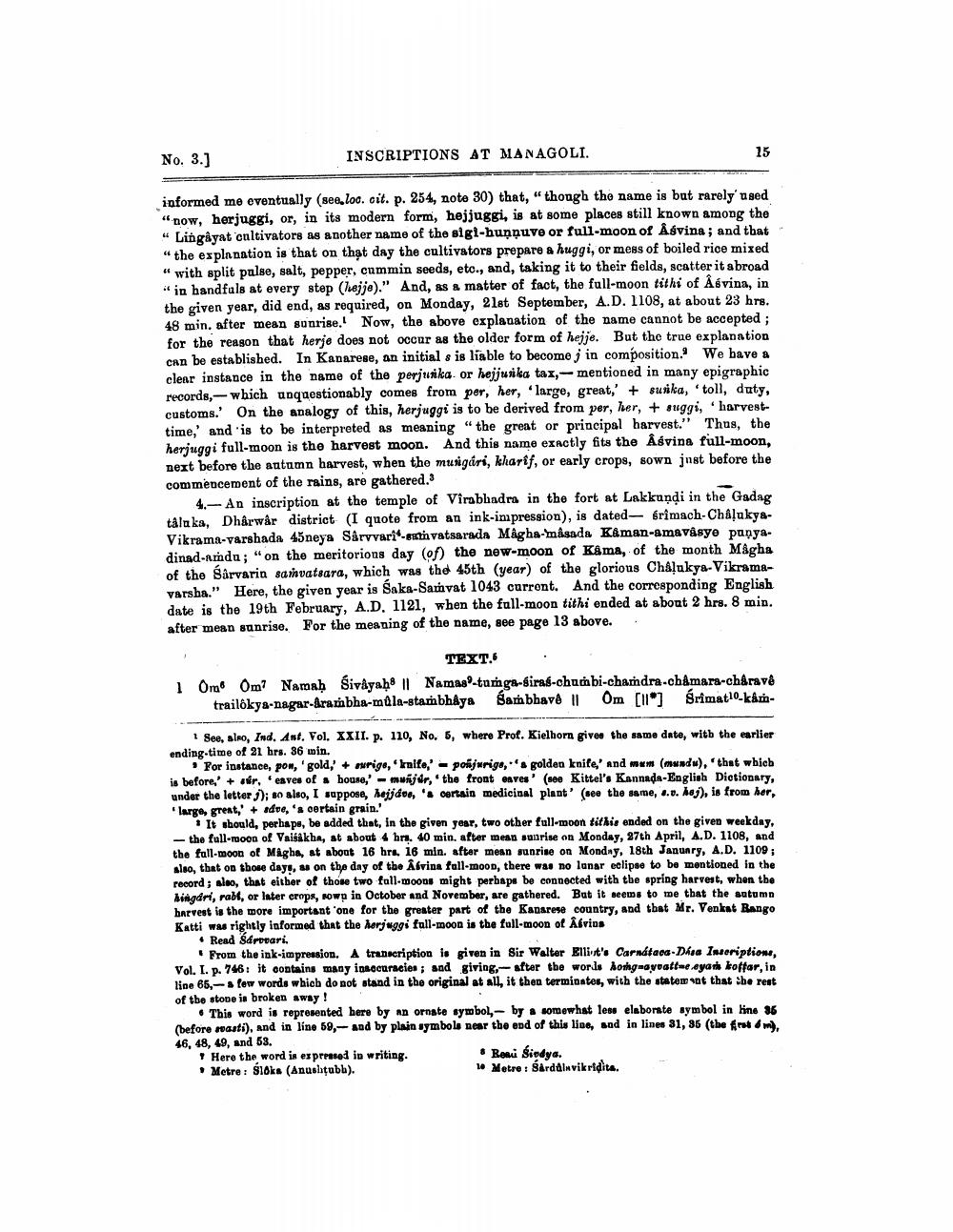________________
No. 3.)
INSCRIPTIONS AT MANAGOLI.
15
informed me eventually (see. loc. cit. p. 254, note 30) that, “though the name is but rarely used "now, herjuggi, or, in its modern form, hejjuggi, is at some places still known among the · Lingayat cultivators as another name of the sigi-huņņuve or full-moon of Asvina ; and that “the explanation is that on that day the cultivators prepare a huggi, or mess of boiled rice mixed " with split pulse, salt, pepper, cummin seeds, etc., and, taking it to their fields, scatter it abroad "in handfals at every step (luejje)." And, as a matter of fact, the full-moon tithi of Åsvina, in the given year, did end, as required, on Monday, 21st September, A.D. 1108, at about 23 hrs. 48 min. after mean sonrise. Now, the above explanation of the name cannot be accepted ; for the reason that herje does not occur as the older form of hejje. But the true explanation can be established. In Kanarese, an initial s is liable to become ; in composition. We have a clear instance in the name of the perjusika or hejjurika tax- mentioned in many epigraphic records - which unquestionably comes from per, her, 'large, great,' + susika, toll, duty, customs. On the analogy of this, herjuggi is to be derived from per, her, + suggi, 'harvesttime,' and 'is to be interpreted as meaning "the great or principal harvest." Thus, the herjuggi full-moon is the harvest moon. And this name exactly fits the Åsvina full-moon, next before the autumn harvest, when the mungári, kharif, or early crops, sown jnst before the commencement of the rains, are gathered.
4.- An inscription at the temple of Virabhadra in the fort at Lakkandi in the Gadag tálaka, Dharwår district (I quote from an ink-impression), is dated - brimach-Châļuky&Vikrama-varshada 45neya Sarvvari-suth vatsarada Magha-masada Kaman-amavasyo panya. dinad-amda ; "on the meritorions day (of) the new-moon of Kama, of the month Magha of the Sårvarin samvatsara, which was the 45th (year) of the glorious Chåļukya-Vikramavarsha." Here, the given year is Saka-Sauvat 1043 curront. And the corresponding English date is the 19th February, A.D. 1121, when the fall-moon tithi ended at about 2 hrs. 8 min. after mean sunrise. For the meaning of the name, see page 13 above. .
TEXT. i Om Om Namah Sivayah | Namas -targa-Siras-chu-bi-chandra chámara-chârave
trailokya-nagar-Aramabha-müla-stambhaya Sambhavê 11 Om [II] Srimat10-kam
1 See, alo, Ind. Ant. Vol. XXII. p. 110, No. 5, where Prof. Kielhorn given the same date, with the earlier ending time of 21 hrs. 36 min.
. For instance, pon, 'gold, + wrigo, 'knife,' posjurige, golden knite, and madu), 'that wbieb in before,' + eur, eaves of house,'-mwijdr, the front enves' (see Kittel's Kannada-English Dictionary, under the letter /); so also, I suppose, hejjdos, certain medicinal plant' (see the same, a.v. ha), is from her, "large, great,' + adre, 's certain grain.'
• It should, perhape, be added that, in the given year, two other full-moon tilhe ended on the given weekday, - the full-moon of Vaisakha, at about 4 br. 40 min. after mean sunrise on Monday, 27th April, A.D. 1108, and the fallmoon of Mighe, at about 16 hrs. 16 min. after mean ranrise on Monday, 18th January, A.D. 1109; also, that on those days, as on the day of the Alvina full-moon, there was no lanar eclipse to be mentioned in the record; sloo, that either of those two fall moons might perbapa be connected with the spring harvest, when the hingari, rabt, or later crops, Rowp in October and November, are gathered. But it seems to me that the satumn harvest is the more important 'one for the greater part of the Kanarese country, and that Mr. Venkat Rango Katti was rightly informed that the herjuggs full-moon is the full-moon of Afrius
• Read Sdrutari.
From the ink-impression. A transcription is given in Sir Walter Elli's Carnataca-Dhia Inscriptions, Vol. I. p. 746. it contains many inaccuracies and giving, after the words hotgayvaffee ayar koftar, in line 65,- few words which do not stand in the original at all, it then terminatos, with the statem sat that the rest of the stone is broken away!
This word is represented here by an ornate symbol- by somewhat les elaborate symbol in line 36 (before masti), and in line 59,- and by plain symbole near the end of this line, sed in lines 31, 36 (the from 46, 48, 49, and 53. + Here the word is expressed in writing.
• Renu Siodya. • Metre: $10ks (Anushtabb).
10 Metre : Sárdalsvikridita.




